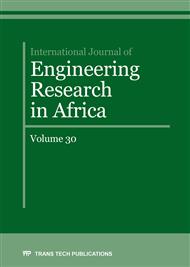[1]
D.F.B. Lima, F.A. Zanella, M.K. Lenzi, P.M. Ndiaye, Modeling and Simulation of Water Gas Shift Reactor: An Industrial Case, Petrochemicals, InTech, (2012).
Google Scholar
[2]
J.L. Borges, Diagrama de fontes de hidrogênio. Dissertação de Mestrado em Tecnologia de Processos Químicos e Bioquímicos. Universidade Federal do Rio de Janeiro. Rio de Janeiro. Brasil, (2009).
DOI: 10.23939/chcht12.04.473
Google Scholar
[3]
A. Giwa, Steady-State Modeling of n-butyl acetate transesterification process using Aspen PLUS: conventional versus integrated, ARPN Journal of Engineering and Applied Sciences, 7(12) (2012) 1555-1564.
Google Scholar
[4]
A. Giwa, Methyl acetate reactive distillation process modeling, simulation and optimization using Aspen Plus. ARPN Journal of Engineering and Applied Sciences, 8(5) (2013) 386-392.
Google Scholar
[5]
S.O. Giwa, A. Giwa, H. Hapoglu, Investigating the effects of some parameters on hydrogen sulphide stripping column using Aspen HYSYS, ARPN Journal of Engineering and Applied Sciences, 8(5) (2013) 338-347.
Google Scholar
[6]
A. Giwa, S.O. Giwa, H. Hapoglu, Adaptive neuro-fuzzy inference systems (ANFIS) modeling of reactive distillation process, ARPN Journal of Engineering and Applied Sciences, 8(7) (2013) 473-479.
Google Scholar
[7]
A. Giwa, S. Karacan, Simulation and optimization of ethyl acetate reactive packed distillation process using Aspen Hysys, The Online Journal of Science and Technology, 2(2) (2012) 57-63.
Google Scholar
[8]
A. Giwa, S. Karacan, Nonlinear black-box modeling of a reactive distillation process, International Journal of Engineering Research & Technology, 1(7) (2012) 548-557.
Google Scholar
[9]
A. Giwa, S. Karacan, Decoupling control of a reactive distillation process using Tyreus-Luyben Technique, ARPN Journal of Engineering and Applied Sciences, 7(10) (2012) 1263-1272.
Google Scholar
[10]
A. Giwa, S.O. Giwa, Isopropyl myristate production process optimization using response surface methodology and MATLAB, International Journal of Engineering Research & Technology, 2(1) (2013) 853-862.
Google Scholar
[11]
A. Giwa, S.O. Giwa, Estimating the optimum operating parameters of olefin metathesis reactive distillation process, ARPN Journal of Engineering and Applied Sciences, 8(8) (2013) 614-624.
Google Scholar
[12]
A. Giwa, S.O. Giwa, İ. Bayram, S. Karacan, Simulations and economic analyses of ethyl acetate productions by conventional and reactive distillation processes using Aspen Plus, International Journal of Engineering Research & Technology, 2(8) (2013).
Google Scholar
[13]
A. Giwa, Solving the dynamic models of reactive packed distillation process using difference formula approaches, ARPN Journal of Engineering and Applied Sciences, 9(2) (2014) 98-108.
Google Scholar
[14]
A. Giwa, A. Bello, S.O. Giwa, Performance analyses of fatty acids in reactive distillation process for biodiesel production, International Journal of Scientific & Engineering Research, 5(12) (2014) 529-540.
Google Scholar
[15]
A. Giwa, A. Bello, S.O. Giwa, Artificial neural network modeling of a reactive distillation process for biodiesel production, International Journal of Scientific & Engineering Research, 6(1) (2015) 1175- 1191.
Google Scholar
[16]
A. Giwa, S.O. Giwa, A.A. Adeyi, Dynamics and servo control of biodiesel purity from a reactive distillation process, International Journal of Scientific & Engineering Research, 6(8) (2015) 146-156.
Google Scholar
[17]
A. Giwa, S.O. Giwa, Modelling and simulation of a reactive distillation process for fuel additive production, Journal of Environmental Science, Computer Science and Engineering & Technology, Section C: Engineering & Technology, 5(1) (2016) 63-74.
Google Scholar
[18]
A. Giwa, S. Karacan, Modeling and simulation of a reactive packed distillation column using delayed neural networks, Chaotic Modeling and Simulation, 2(1) (2012) 101-108.
Google Scholar
[19]
A. Giwa, S.O. Giwa, Layer-recurrent neural network modelling of reactive distillation process, Chaotic Modeling and Simulation, 2(4) (2013) 647-656.
Google Scholar
[20]
A. Giwa, S. Karacan, Development of dynamic models for a reactive packed distillation column, International Journal of Engineering, 6(3) (2012) 118-128.
Google Scholar
[21]
S.C. Nwambuonwo, A. Giwa, Modelling, simulation and optimization of fatty acid methyl ester reactive distillation process using Aspen HYSYS. International Journal of Science and Research, 4(7) (2015) 1218-1224.
DOI: 10.4028/www.scientific.net/jera.27.36
Google Scholar
[22]
A. Giwa, S.O. Giwa, Investigating the effects of operating parameters of a reaction integrated distillation process for SAME production using Aspen PLUS. International Journal of Science and Research, 4(7) (2015) 2349-2356.
Google Scholar
[23]
A. Giwa, S.O. Giwa, Effects of feed ratio on the product quality of same reactive distillation process, Advances in Applied Science Research, 6(10) (2015) 135-143.
Google Scholar
[24]
P. Giunta, N. Amadeo, M. Laborde, Simulation of a low temperature water gas shift reactor using the heterogeneous model/application to a PEM fuel cell, Journal of Power Sources, 156(2) (2006) 489-496.
DOI: 10.1016/j.jpowsour.2005.04.036
Google Scholar
[25]
A. Brunetti, A. Caravella, G. Barbieri, E. Drioli, Simulation study of water gas shift reaction in a membrane reactor, Journal of Membrane Science, 306(1-2) (2007) 329–340.
DOI: 10.1016/j.memsci.2007.09.009
Google Scholar
[26]
W. -H. Chen, M. -R. Lin, T.L. Jiang, M. -H. Chen, Modeling and simulation of hydrogen generation from high-temperature and low-temperature water gas shift reactions, International Journal of Hydrogen Energy, 33(22) (2008) 6644–6656.
DOI: 10.1016/j.ijhydene.2008.08.039
Google Scholar
[27]
P. Boutikos, V. Nikolakis, A Simulation study of the effect of operating and design parameters on the performance of a water gas shift membrane reactor, Journal of Membrane Science, 350(1–2) (2010) 378–386.
DOI: 10.1016/j.memsci.2010.01.014
Google Scholar
[28]
R.J.B. Smith, L. Muruganandam, S.M. Shekhar, CFD analysis of water gas shift membrane reactor, Chemical Engineering Research and Design, 89(11) (2011) 2448–2456.
DOI: 10.1016/j.cherd.2011.02.031
Google Scholar
[29]
M.D. Falco, V. Piemonte, A. Basile, Simulation of water gas shift membrane reactors by a two-dimensional model, Computer Aided Chemical Engineering, 29 (2011) 1643–1647.
DOI: 10.1016/b978-0-444-54298-4.50107-0
Google Scholar
[30]
A. Giwa, S.O. Giwa, Simulation, sensitivity analysis and optimization of hydrogen production by steam reforming of methane using Aspen Plus, International Journal of Engineering Research & Technology, 2(7) (2013) 1719-1729.
Google Scholar
[31]
A. Giwa, Y.O. Raji, S.O. Giwa, Water-gas shift process for hydrogen production – effects of operating parameters, International Journal of Scientific & Engineering Research, 5(5) (2014) 1474-1483.
Google Scholar
[32]
Aspen, Aspen HYSYS V8. 4 [30. 0. 0. 8433], Aspen Technology, USA, (2013).
Google Scholar


